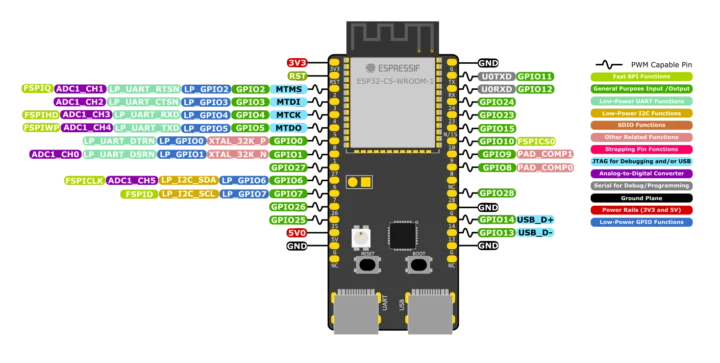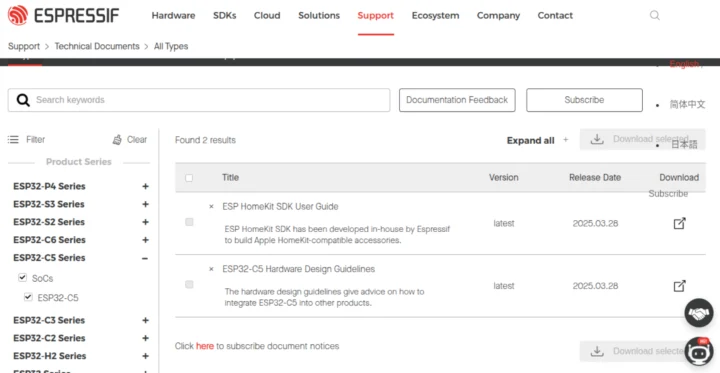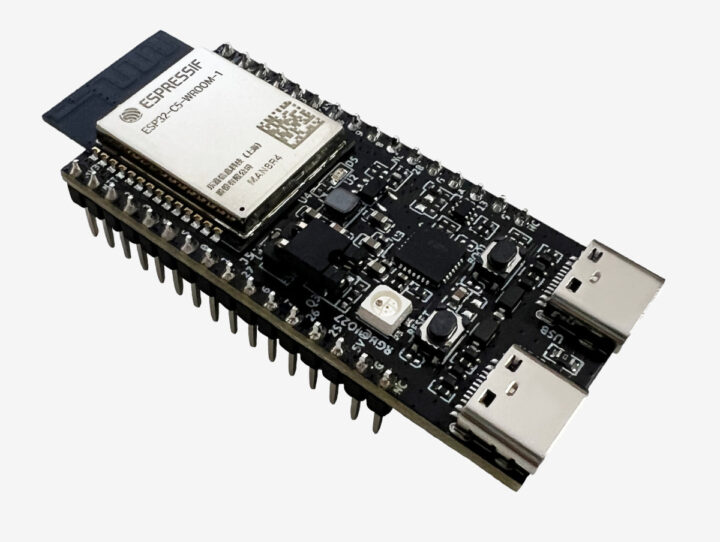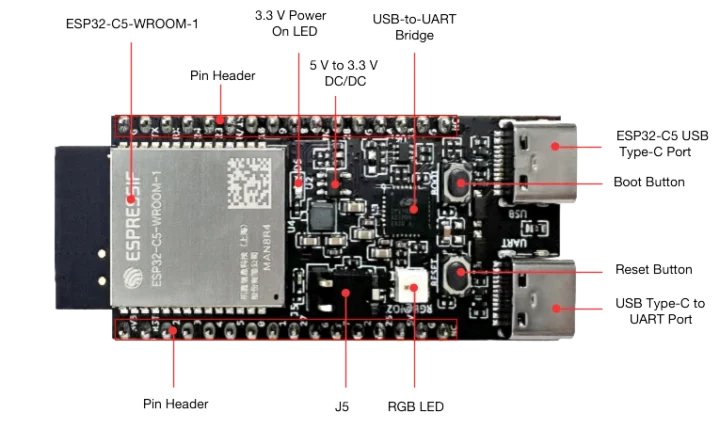Espressif Systems has just started mass production of the ESP32-C5 RISC-V wireless microcontroller with dual-band (2.4/5 GHz) WiFi 6, Bluetooth LE, and 802.15.4 (Zigbee, Thread) connectivity. The ESP32-C5-DevKitC-1 development is now available for about $15 on AliExpress, and should soon show up on the company’s Amazon store.
So far, WiFi-capable Espressif microcontrollers have only supported 2.4 GHz WiFi since it’s cheaper and offers better range for IoT applications, but some applications may benefit from 5 GHz WiFi, so the company unveiled the ESP32-C5 dual-band WiFi 6 and BLE RISC-V MCU in June 2022. Design probably took longer than expected, but we noted documentation for an ESP32-C5 beta board in March 2024, and finally, the company has just announced that mass production has started. We’ll have a closer look at the ESP32-C5-DevKitC-1 board in this article, since it is different from the beta board.
ESP32-C5-DevKitC-1 specifications:
- Wireless module – ESP32-C5-WROOM-1
- SoC – ESP32-C5
- CPU
- Single-core 32-bit RISC-V processor @ up to 240 MHz
- Low-power RISC-V core @ 40 MHz acting as the main processor for power-sensitive applications
- Memory – 384 KB SRAM on-chip, support for external PSRAM
- Storage – 320 KB ROM, support for external flash
- Connectivity
- Dual-band 802.11ax WiFi 6 in the 2.4GHz and 5 GHz bands, with 802.11b/g/n WiFi 4 standard support for backward compatibility
- 20MHz bandwidth for the 802.11ax mode
- 20/40MHz bandwidth for the 802.11b/g/n mode
- OFDMA (Orthogonal Frequency Division Multiple Access) mechanism for both uplink and downlink
- MU-MIMO capability for downlink
- Target Wake Time (TWT) support allows devices to sleep for an extended time period (important for battery life)
- Bluetooth 5.0 Low Energy (LE)
- 802.15.4 radio for Zigbee 3.0 and Thread 1.3
- Dual-band 802.11ax WiFi 6 in the 2.4GHz and 5 GHz bands, with 802.11b/g/n WiFi 4 standard support for backward compatibility
- CPU
- Memory – 8MB PSRAM
- Storage – 4MB SPI flash
- PCB antenna
- SoC – ESP32-C5
- USB
- USB Type-C port – USB 2.0 full speed up to 12 Mbps (480 Mbps high-speed transfer mode is not supported). Used to power the board, flash applications to the chip, communicate with the chip using USB protocols, as well as for JTAG debugging.
- USB Type-C to UART port – Used to power the board and flash the application to the chip; up to 3 Mbps baudrate.
- Expansion – 2x 16-pin GPIO headers with all I/Os except SPI (used by the flash) – See pinout diagram below
- Misc
- Power LED (3.3V)
- RGB LED driven by GPIO27
- Boot and Reset buttons
- J5 jumper for current measurement
- Power Supply
- 5V via either USB-C ports or 5V and GND pins
- 3.3V via 3V3 and GND pins
- 5V to 3.3V DC/DC switching regulator
- Dimensions – 51.8 x 25.5 mm

The ESP32-C5-DevKitC-1 is more or less the same as the ESP32-C6-DevKitC-1 board, except it relies on an ESP32-C6-WROOM-1 module with dual-band WiFi 6. The ESP32-C5 SoC, WROOM modules, and devkit will be officially supported in the upcoming ESP-IDF v5.5. Arduino support will likely take a few more months. You can find instructions on the documentation page. The ESP32-C5 can also be used as a wireless coprocessor connected to a host microcontroller or application processor using ESP-AT or ESP-Hosted.
While the ESP32-C5-DevKitC-1 board can be purchased directly on Aliexpress, you would need to contact Espressif Systems sales to get the samples of the ESP32-C5 SoC, the ESP32-C5-WROOM-1 module, or the upcoming ESP32-C5-MINI-1U module with an external antenna. More details may be found on the product page, but note that I was unable to find the datasheet, and public documentation is limited. The website will probably be updated soon.


Jean-Luc started CNX Software in 2010 as a part-time endeavor, before quitting his job as a software engineering manager, and starting to write daily news, and reviews full time later in 2011.
Support CNX Software! Donate via cryptocurrencies, become a Patron on Patreon, or purchase goods on Amazon or Aliexpress. We also use affiliate links in articles to earn commissions if you make a purchase after clicking on those links.





